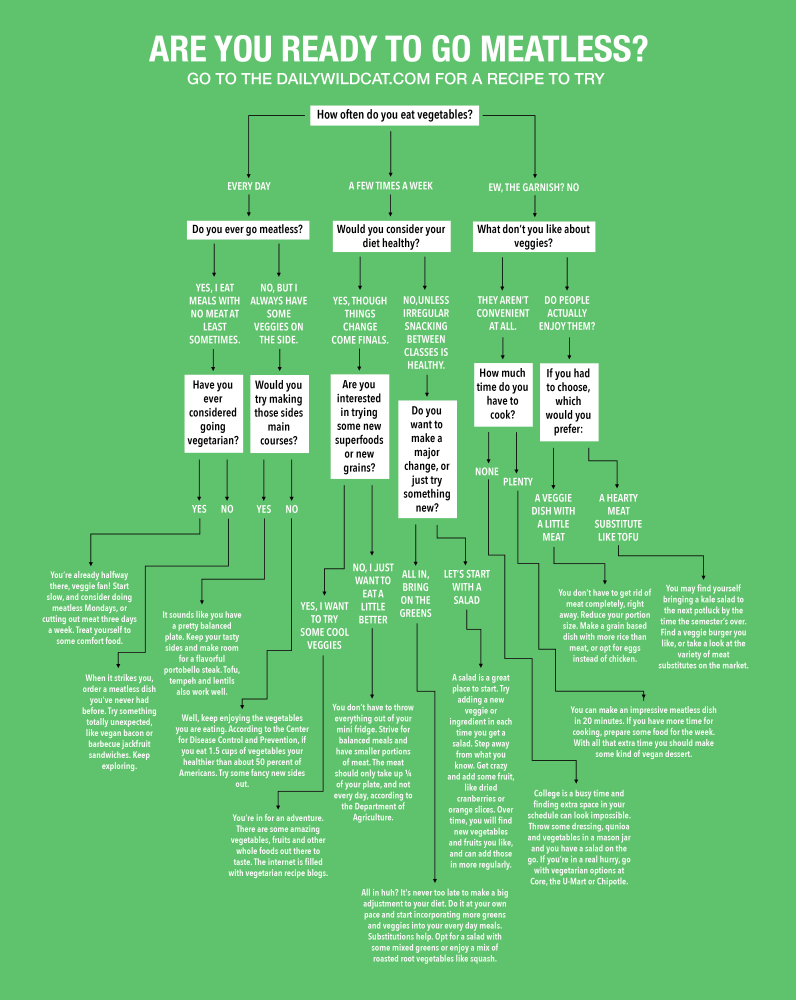Meat eating has become ingrained in American culture, from hamburgers and hot dogs at Fourth of July barbecues to Thanksgiving turkeys and holiday hams. What would happen if meat was taken out of the equation for these holidays, or even every day for that matter? I’m not here to tell you to go vegan, or even vegetarian. I’m here to ask you to consider cutting back on the amount of meat you eat, as it could make a substantial difference to the environment.
Of the world’s greenhouse gas emissions, 14.5 percent are due to livestock, according to the Food and Agriculture Organization of the United Nations. It’s predicted that food-related greenhouse gas emissions would drop 29 percent by 2050 if the world adopted a sustainable diet with less meat.
Meat eaters contribute 16 pounds of carbon gas emissions each day, while vegetarian and pescatarian diets result in 8 pounds and vegan diets only produce 7 pounds daily, so a change in diet is something to consider.
RELATED: One week of eating vegan
The International Livestock Research Institute, the Commonwealth Scientific and Industrial Research Organization and the International Institute for Applied Systems Analysis assessed the livestock industry and found that 285 million tons of meat is produced around the world every year. If this statistic was divided equally among the world’s population, the average person would consume 80 pounds of meat per year.
However, there is a huge divide in meat consumption based on where people live. According to the study, “Biomass use, production, feed efficiencies, and greenhouse gas emissions from global livestock systems,” the average American consumes a whopping 270 pounds of meat annually, while the average Bangladeshi eats only 4 pounds of meat per year. The trend of Americans eating more meat isn’t new. In 2012, NPR displayed global meat consumption on a map, and Americans eat 10 to 12 times more meat than the average person in other countries.
It’s clear that Americans eat substantially more meat than their international counterparts, so the U.S. in particular could benefit from a sustainable diet.
One-fifth of meat production’s greenhouse gas emissions can be attributed to livestock feed, according to the Washington Post.
Livestock alone consumes five times more grain than the U.S. population. If all this grain was given to people, rather than livestock, it could feed almost 800 million people. For a cow to produce 2 pounds of protein, they have to eat 165 to 662 pounds of grass or grain.
Cows in the U.S. are primarily fed corn, soybean meal and other grains, which is a relatively new development. Before the 1970s, the main diet for cattle was grass. The feed that the cows eat cause them to pass gas, and cow’s gas alone is the cause of 20 percent of the methane gas emissions in the U.S. So, if you have the option to, opt for grass-fed beef over grain-fed beef. To grow livestock feed in the U.S., it takes 149 million acres of cropland. Farmers use 167 million pounds of pesticides and 17 billion pounds of nitrogen fertilizer to treat these feed crops. The production of this feed generates a dangerous greenhouse gas called nitrous oxide, which is 300 times worse than carbon dioxide.
RELATED: Sustainable switches are easier than you think
If it’s hard to cut meat out of your diet entirely, an easier thing to do is to cut out red meat (cow, sheep and goat). Red meat is far worse for the environment than other meats, like pork or poultry.
Red meat requires up to five times more feed to produce a pound of protein than pork and poultry. Pork and poultry are the cause of only 10 percent of the total livestock greenhouse emissions, while still producing three times the amount of meat that cattle does. This means pork and poultry are substantially better for the environment. Of course, cutting out meat entirely is an even better option for the environment than cutting back. If you think you can do it, I challenge you to try.
Beef requires 160 times more land than other foods, like potatoes, wheat and rice. Producing beef requires 48 times the amount of water as it does to produce the same amount of vegetables.
Not everyone in the U.S. needs to cut out meat from their lives entirely, but Americans should try to develop more sustainable diets with less meat. Red meat in particular, as it is worse for the environment.

—Claudia Drace is new to being a vegetarian and will be opting out of eating turkey for the first time this Thanksgiving
Follow the Daily Wildcat on Twitter









